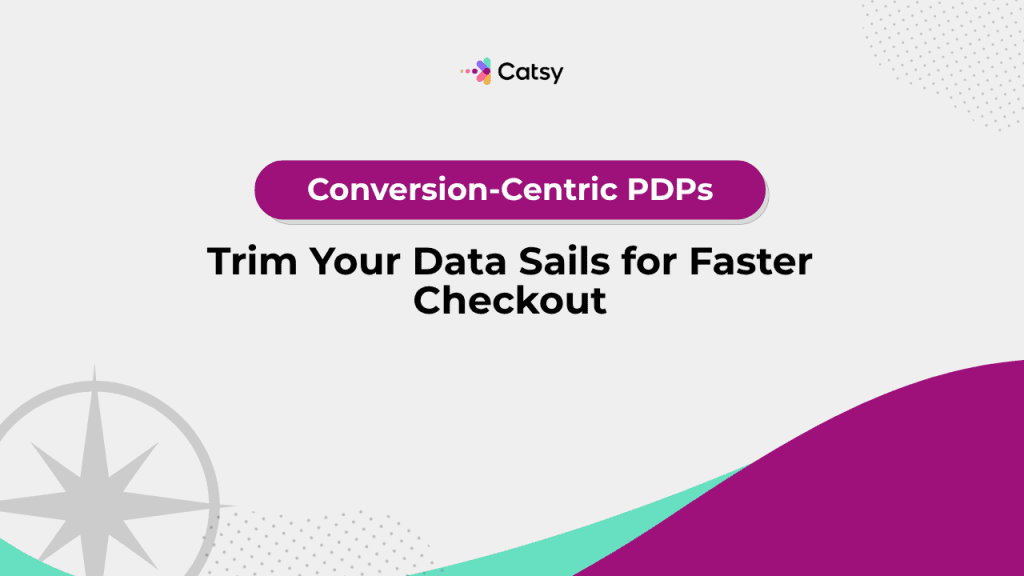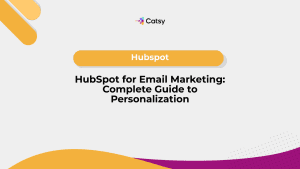Conversion-Centric PDPs: Trim Your Data Sails for Faster Checkout
In the vast sea of digital commerce, your Product Detail Pages (PDPs) are the vessels that pull – right alongside your shopper. Their cargo includes visuals and trust signals that make your shopper confident in their decision to come aboard.
If your data already lives in Catsy, tuning PDPs for different channels usually comes down to mapping the fields you already trust, switching on a few rules, and pushing updates. This post shows you how to do that without rebuilding everything from scratch.

1. The Anatomy of a High-Performing PDP (Operator View)
A durable PDP hull has four required sections. Use this as your baseline audit:
- A Scan-Friendly Title Block: Clear product identity + differentiator (size, material, compatibility). Titles don’t need to sell; they need to match your shopper’s intent.
- Decision Specs Above the Fold: The 5 to 7 attributes shoppers check before scrolling (fit, size, voltage, capacity, compatibility, pack qty). If you already track these in Catsy, you can expose them across each channel with just a few field maps.
- Credibility Media: At least one hero image plus 1 to 3 context or scale visuals. Videos are optional, but they’re powerful in spec-heavy categories! If assets are linked in Catsy DAM, attaching them to outbound feeds is quick.
- Trust Signals & Policies: Certifications, warranty, return basics. These can be metafield-driven so you don’t repeat boilerplate.
- Quick Check: Print three of your top PDPs and highlight the decision data that’s visible without scrolling. If your structured data (not paragraph copy) accounts for less than 60 percent, you’ve got conversion headroom.
In this Article
2. Why Shopify Metafields = Precision Rigging (Without Heavy Lifting)
Metafields let you place structured data exactly where shoppers look. This could be size tables, material callouts, region warnings, or install notes. With Catsy you can:
- Map attributes to metafields once, then reuse across products. (No hand-editing per SKU.)
- Adjust formatting per template so that long specs show as tables, short specs as bullets.
- Localize units or warnings for specific stores and regions.
Most teams set up their first metafield mapping in under an hour. After that, adding categories becomes a few-click repeat task.
3. Light-Touch PDP Enhancements You Can Turn On Gradually
You don’t need to overhaul every PDP. Start with small improvements that reduce friction:
- Decision Bullets From Existing Attributes
If you already track size, material, use case, and compatibility in Catsy, you can generate a standardized bullet group for each PDP. It’s one rule, applied broadly. - Image-to-Variant Linking
Drag or bulk map variant images so color/size selections show the right photo. Fixes a common return driver. - Spec Tables for Technical Products
Output a structured table (such as dimensions, operating range, safety rating) into a metafield block. Easier to compare; fewer support tickets. - Region Notes / Compliance Flags
If an item requires a Prop 65 warning in CA or different electrical rating in EU, surface this in a small callout panel. Keeps trust intact.
Each of these can be rolled out category by category, with no big bang needed.
Make Catsy DAM and PIM Software an Extension of Your Team
Book a Free Demo4. Monitoring Headwinds: Simple Metrics That Tell You Where to Trim
Rather than measuring everything, watch a few signals tied to PDP decision quality:
Metric | What It Suggests | What to Check First | Typical Fix |
High PDP bounce | Shopper didn’t see match | Title + hero image alignment | Clarify identity, add key spec bullet |
High add‑to‑cart + high returns | Mismatch at decision spec | Fit/compatibility, size table | Add structured spec + warning |
Low mobile conversion vs desktop | Data below fold on mobile | Bullet compression | Move spec block up via metafields |
Retailer rejections | Feed schema gaps | Required attributes missing | Map fields + validation rule |
You can pull most of these signals from commerce analytics + Catsy export validation. You don’t need a data science crew to get directional answers!
5. Directional Stories (Names Withheld)
These are real patterns we’ve seen across teams working in Catsy. Numbers are directional; your mileage will vary, so adapt these to your unique business.
Outdoor Gear Brand – Standardized 6 decision bullets (Weight, Capacity, Weather Rating, Packed Size, Use Season, Warranty). Mobile PDP exits dropped in the next seasonal cycle.
Home Goods Seller – Added size visuals + localized units (in/cm) via metafields before a summer campaign. Support tickets asking “Will this fit?” fell noticeably.
Industrial Parts Supplier – Linked compatibility tables to key assemblies. Wrong-part returns dropped in a high-volume SKU class.
6. PDP Navigation Checklist (Copy/Paste to Your Planner)
Use this as a working map for each category rollout:
☐ Identify top decision attributes per product family.
☐ Confirm data exists in Catsy (or import).
☐ Map to Shopify metafields (display type: bullet, table, callout).
☐ Attach hero and context images from Catsy DAM.
☐ Add region/compliance micro-callouts where required.
☐ Preview on mobile theme.
☐ Publish test batch (start with 25 SKUs or fewer) and monitor.
☐ Expand to full category once stable.
7. Beyond the PDP – Connected Journeys in a Few Clicks
Once PDP decision data lives in structured fields, you can repurpose it easily!
- Build comparison charts across related SKUs.
- Feed key specs into landing pages or buyer guides without retyping.
- Trigger emails or ads that pull in top attributes (capacity, finish, compatibility).
Because the data lives within a single source of truth, these repurposes become configuration tasks, not copy rewrites.
Conclusion – Keep Your Flagship Light, Fast, and Accurate
You don’t have to rebuild PDPs to get better conversion. Start with the decision data shoppers scan first. Map it. Preview. Launch. Iterate. Most of the heavy lifting is just getting clean data in one place. After that, tuning layouts becomes a few clicks per channel.
Want more tips, tutorials, and insights on product content and e-commerce operations?
Stay connected. We post regularly to help brands like yours scale smarter.
Are You Ready To streamline your product content management?
Subscribe For More Content
Sign up for monthly tips on how to drive revenue with product content.




